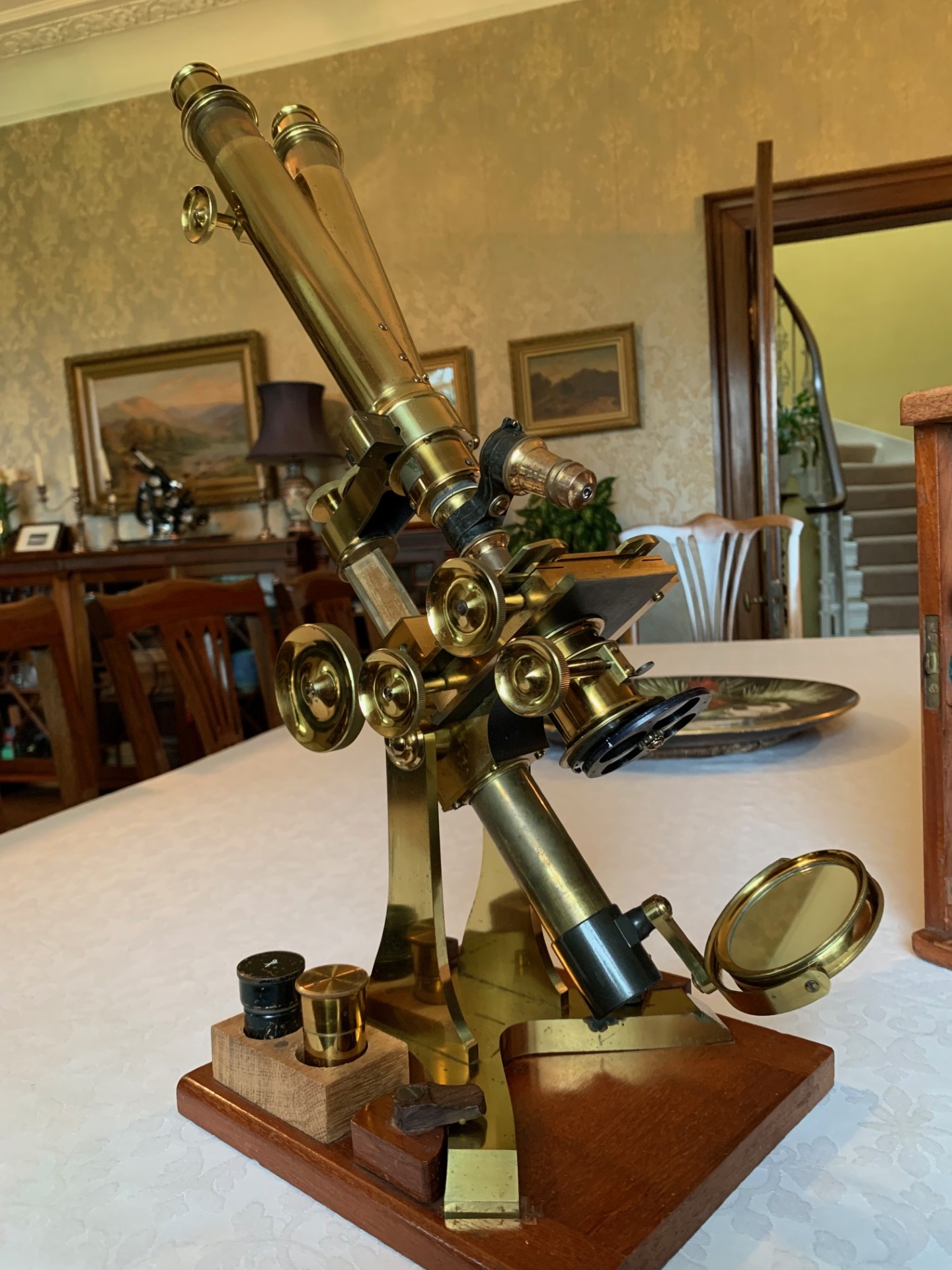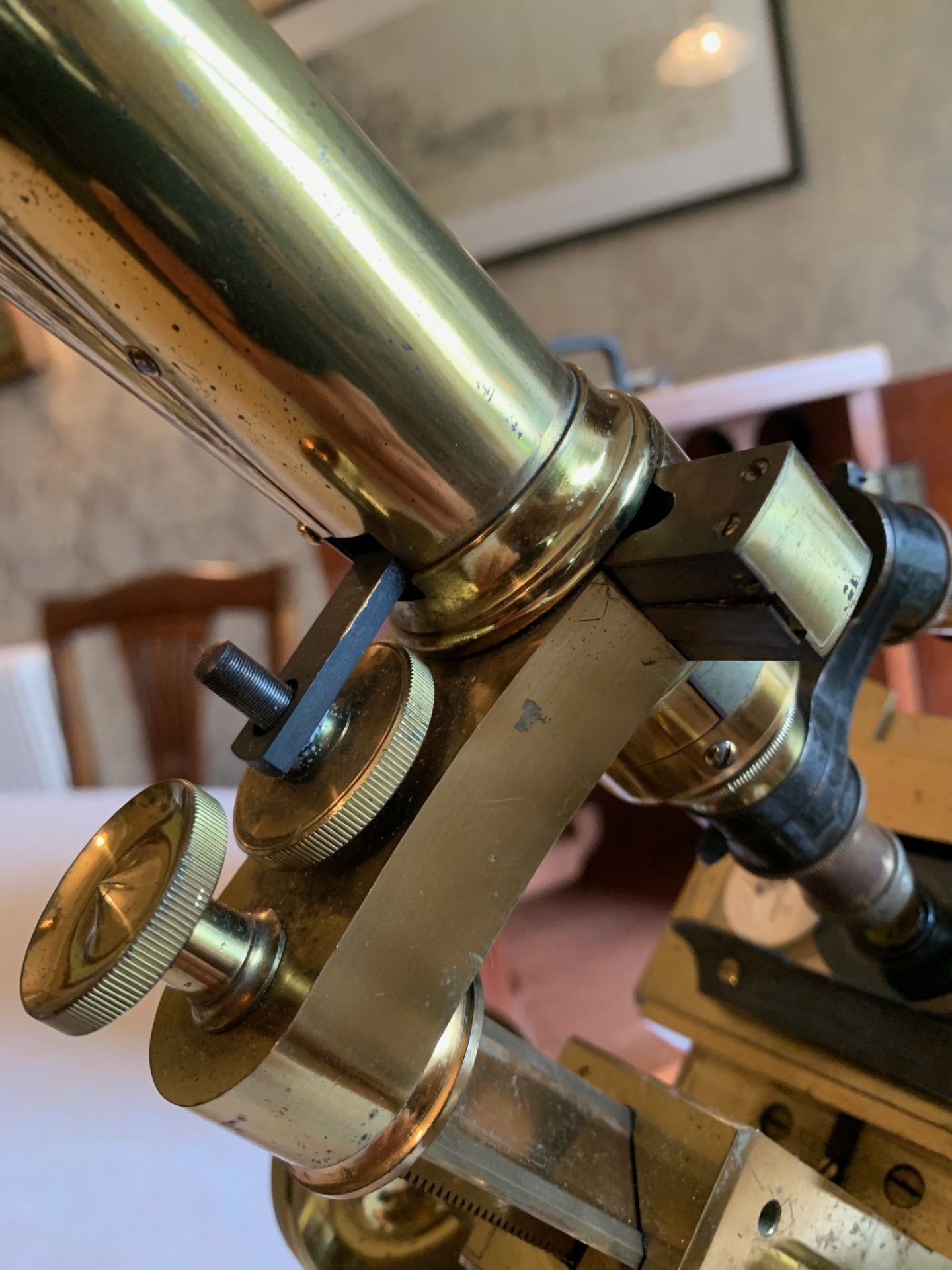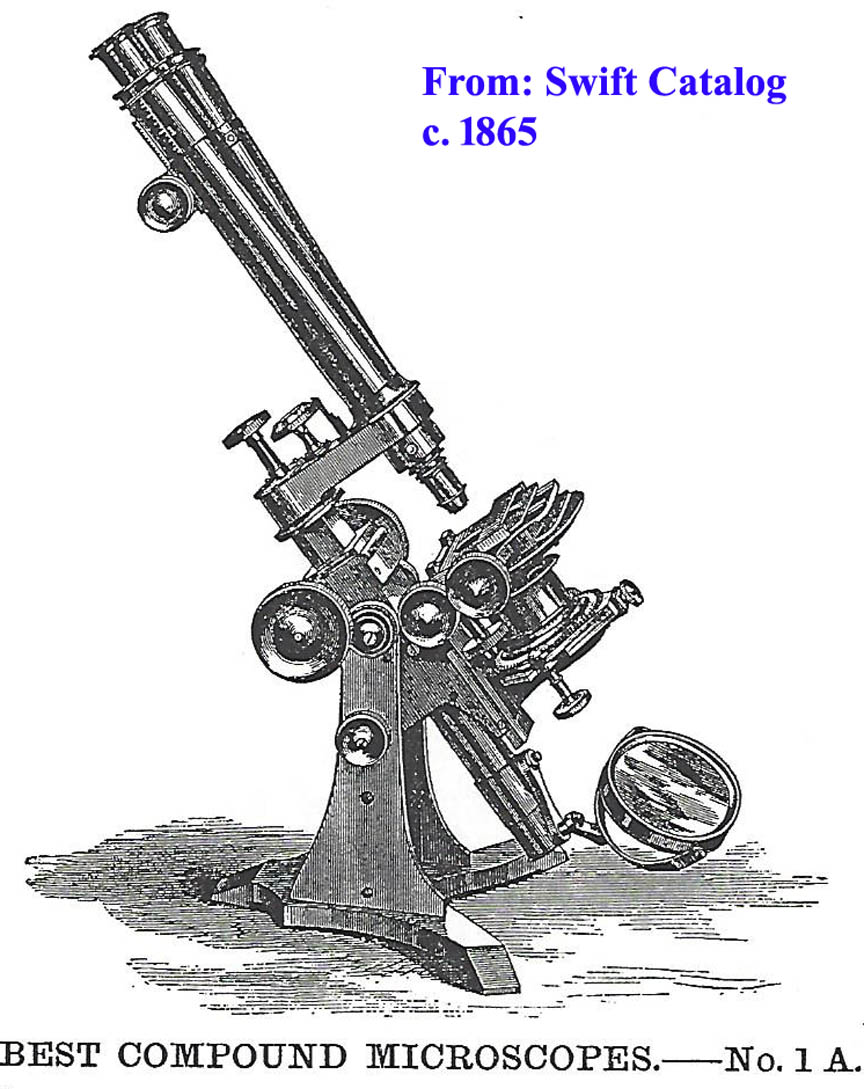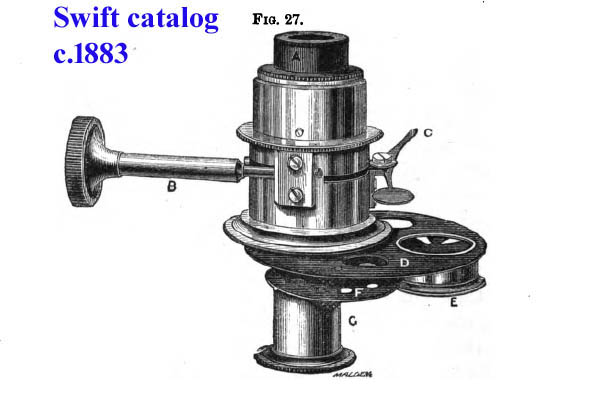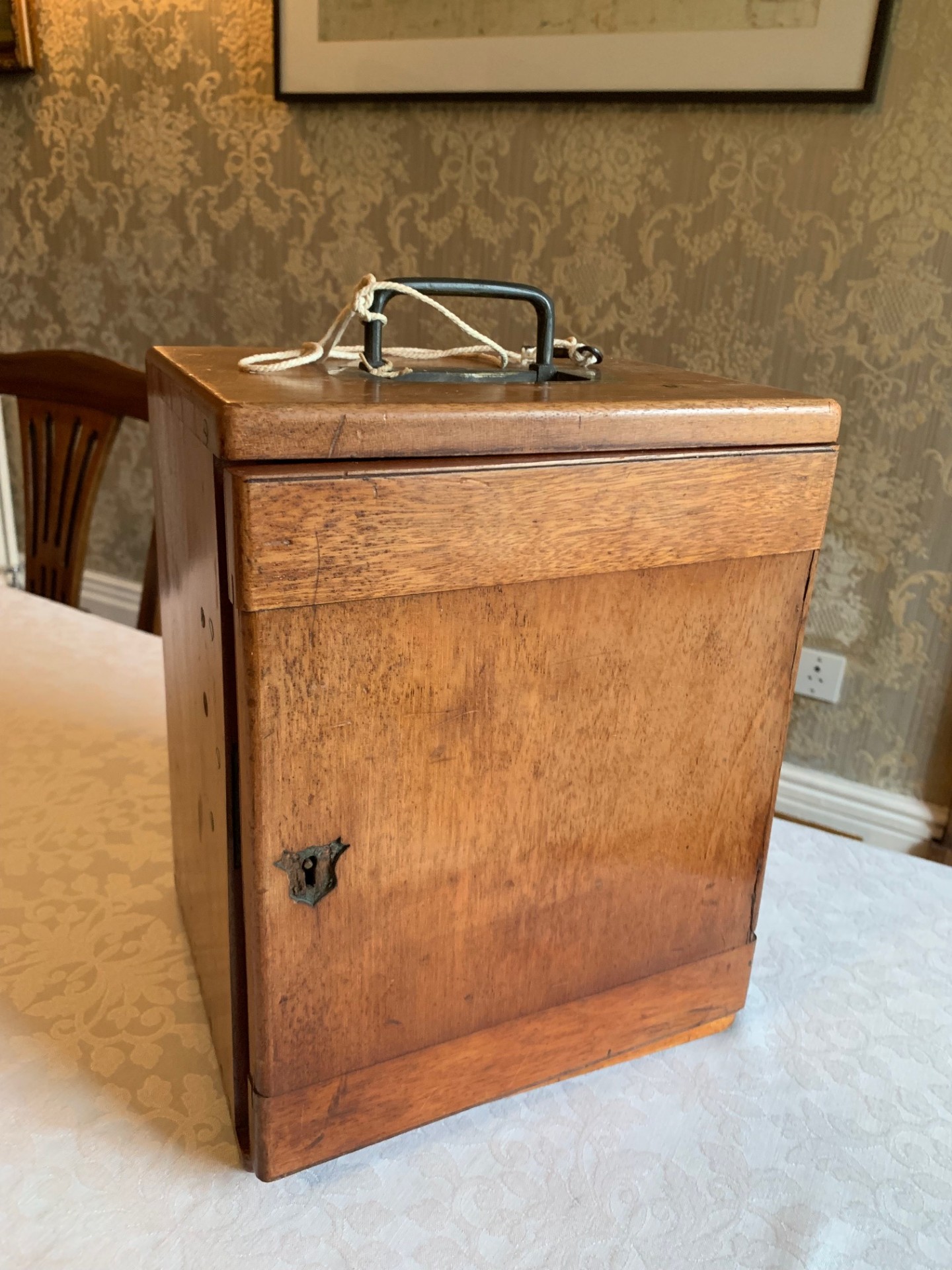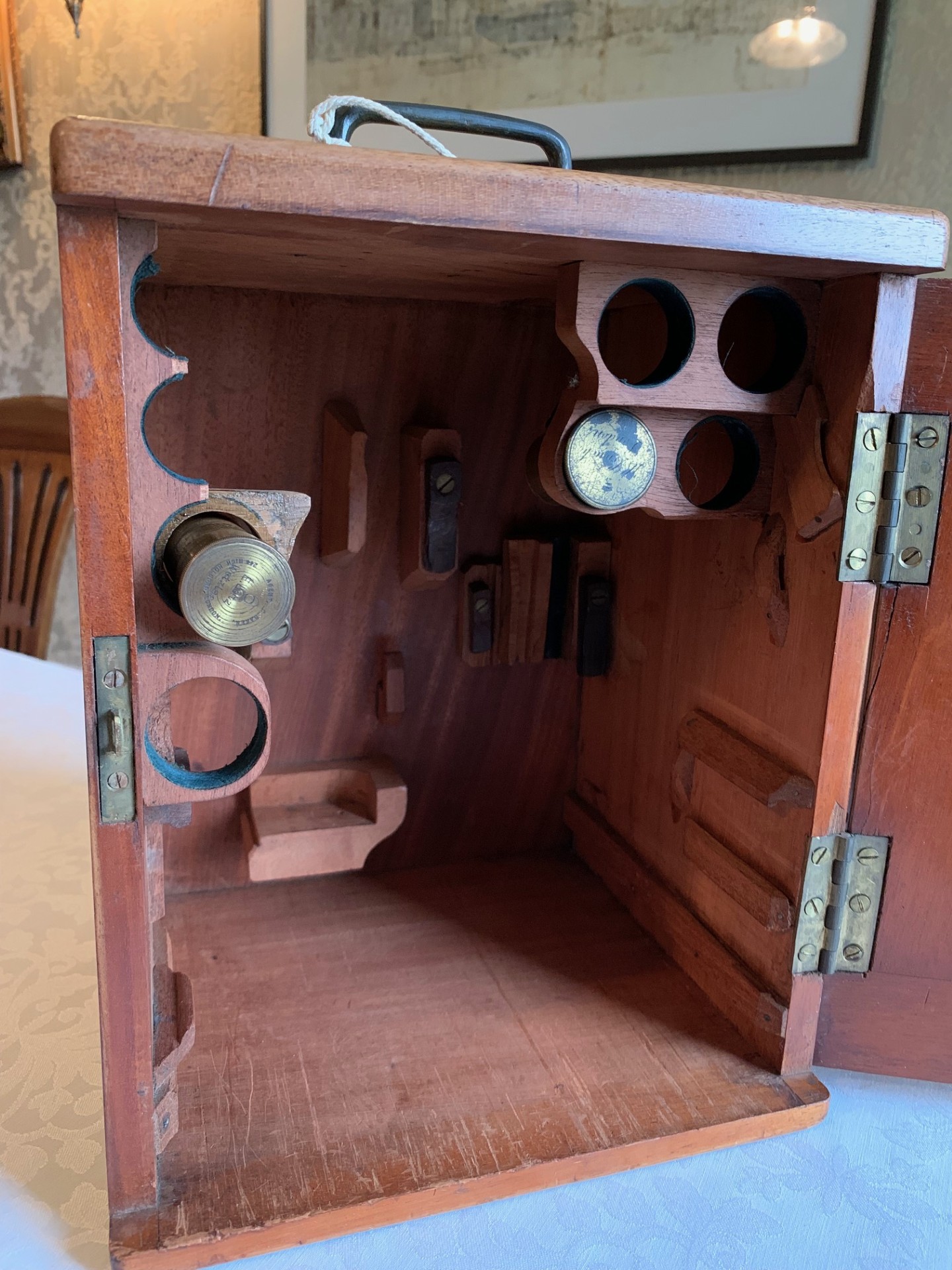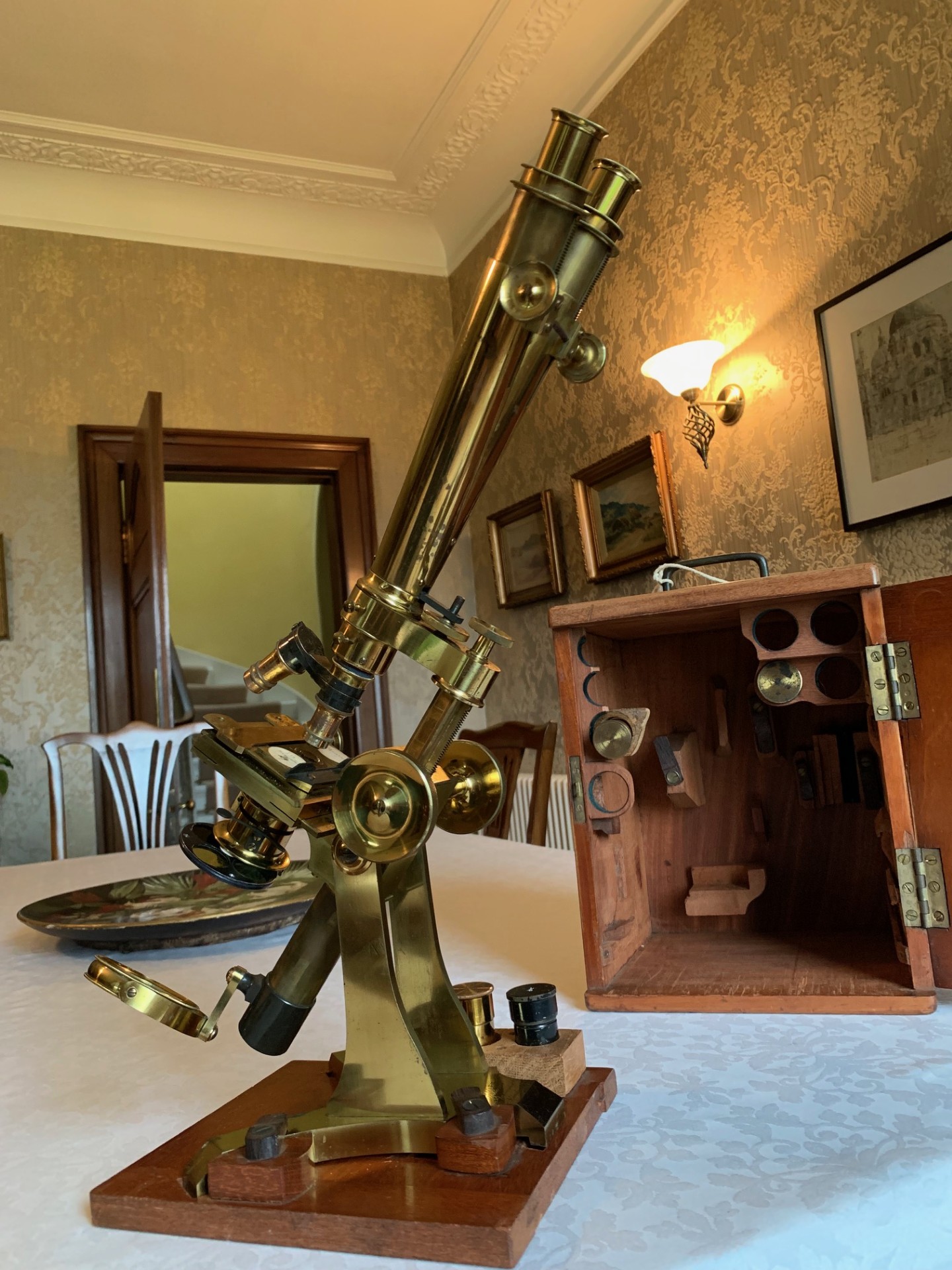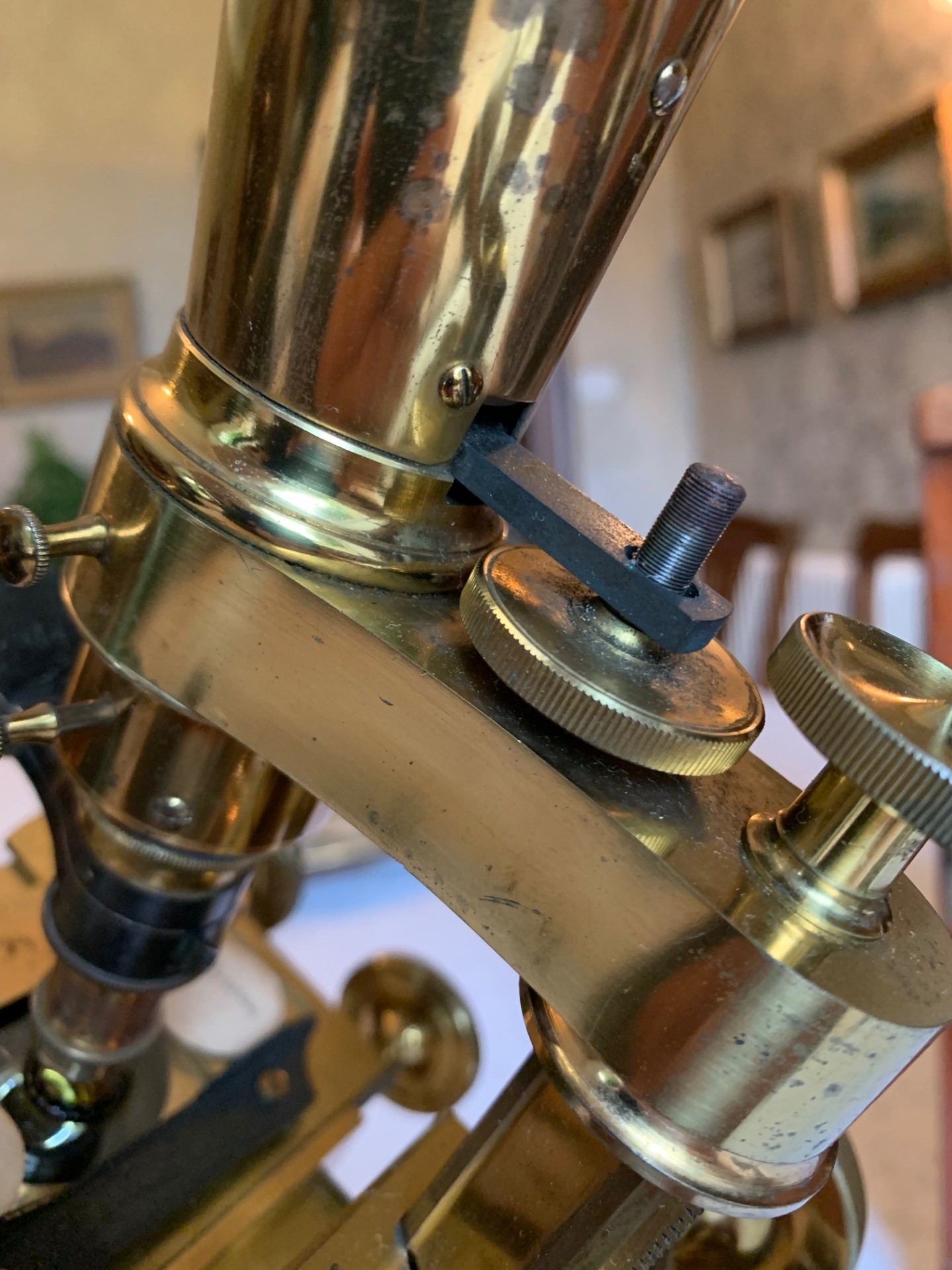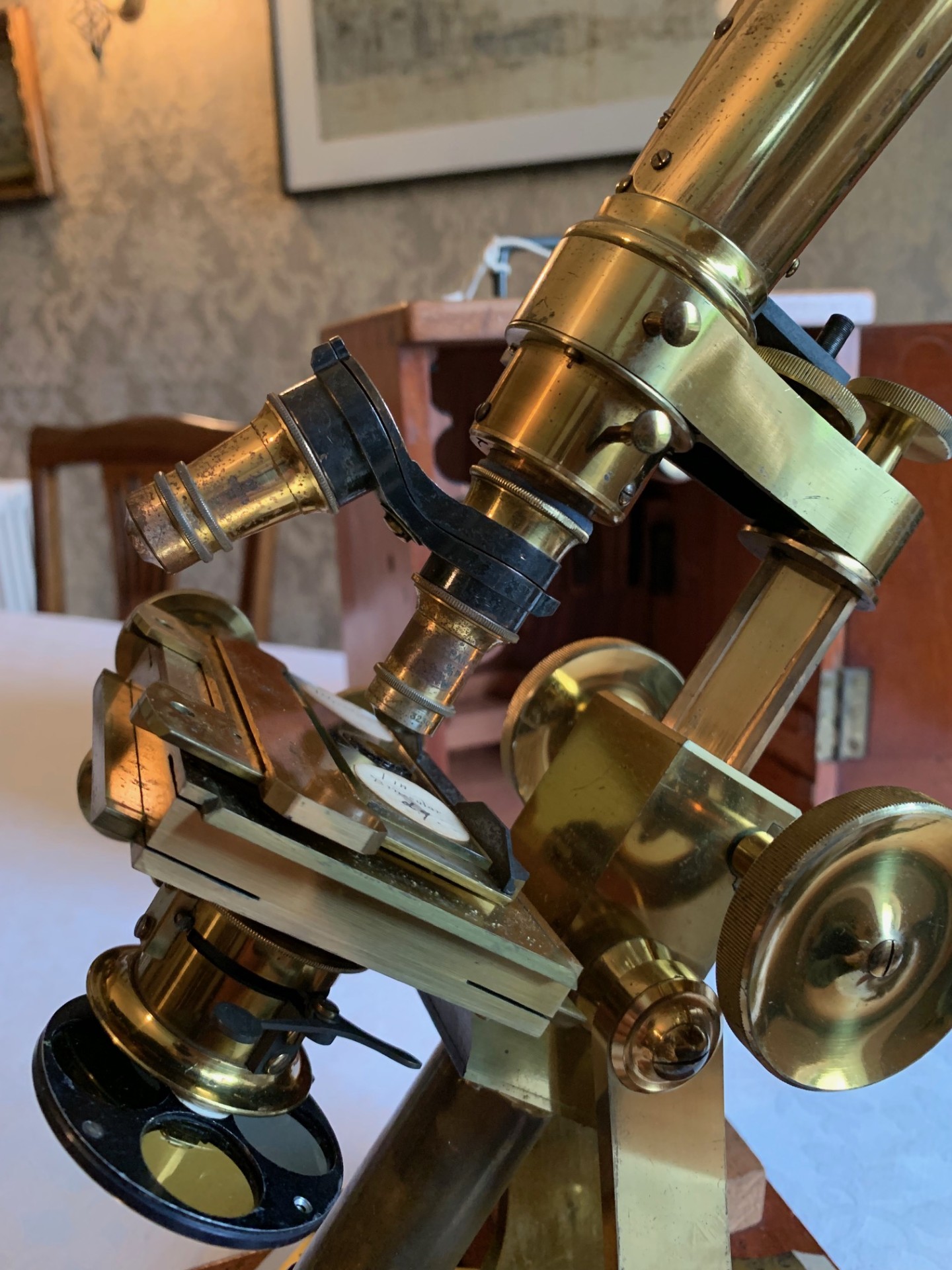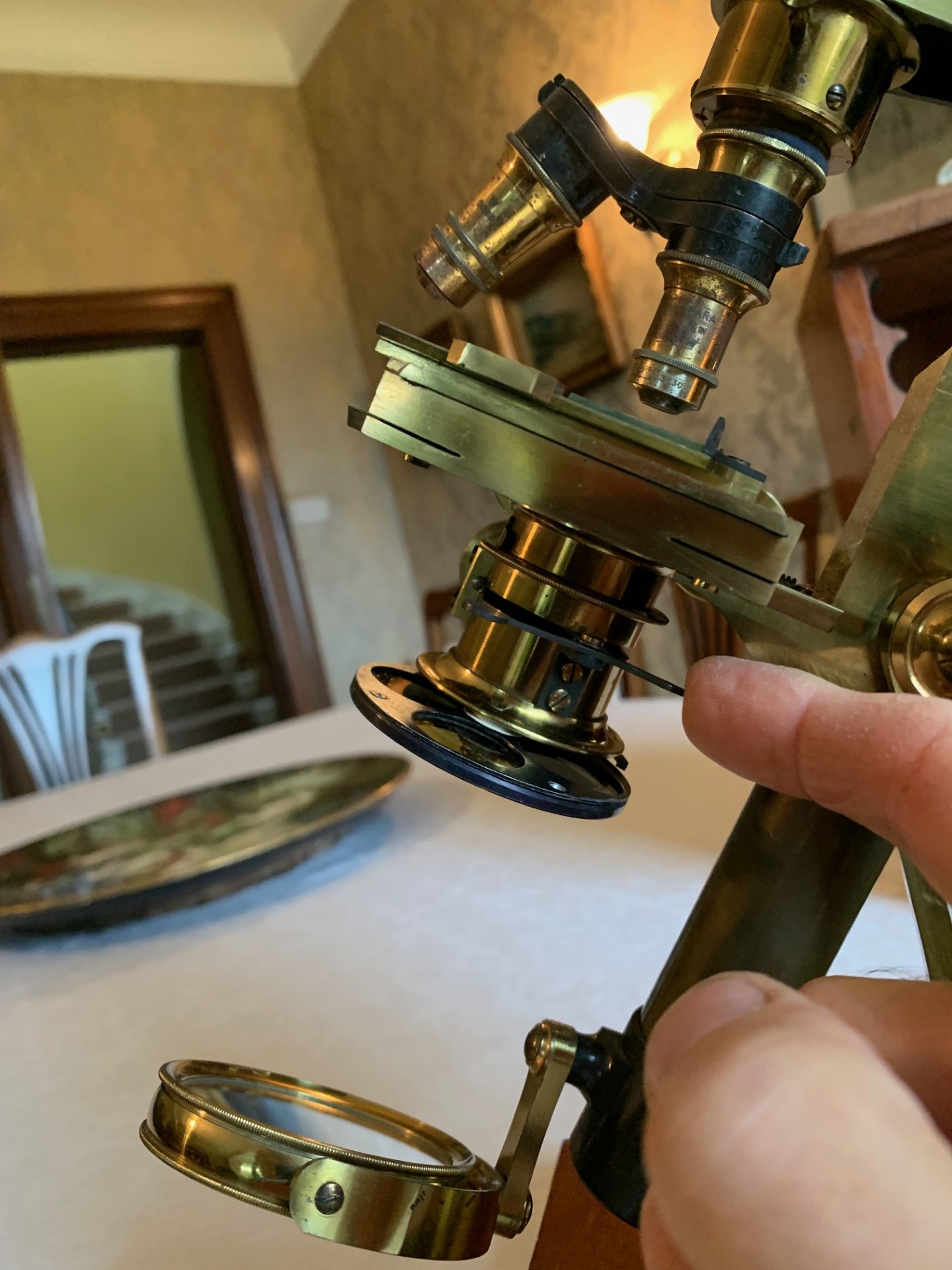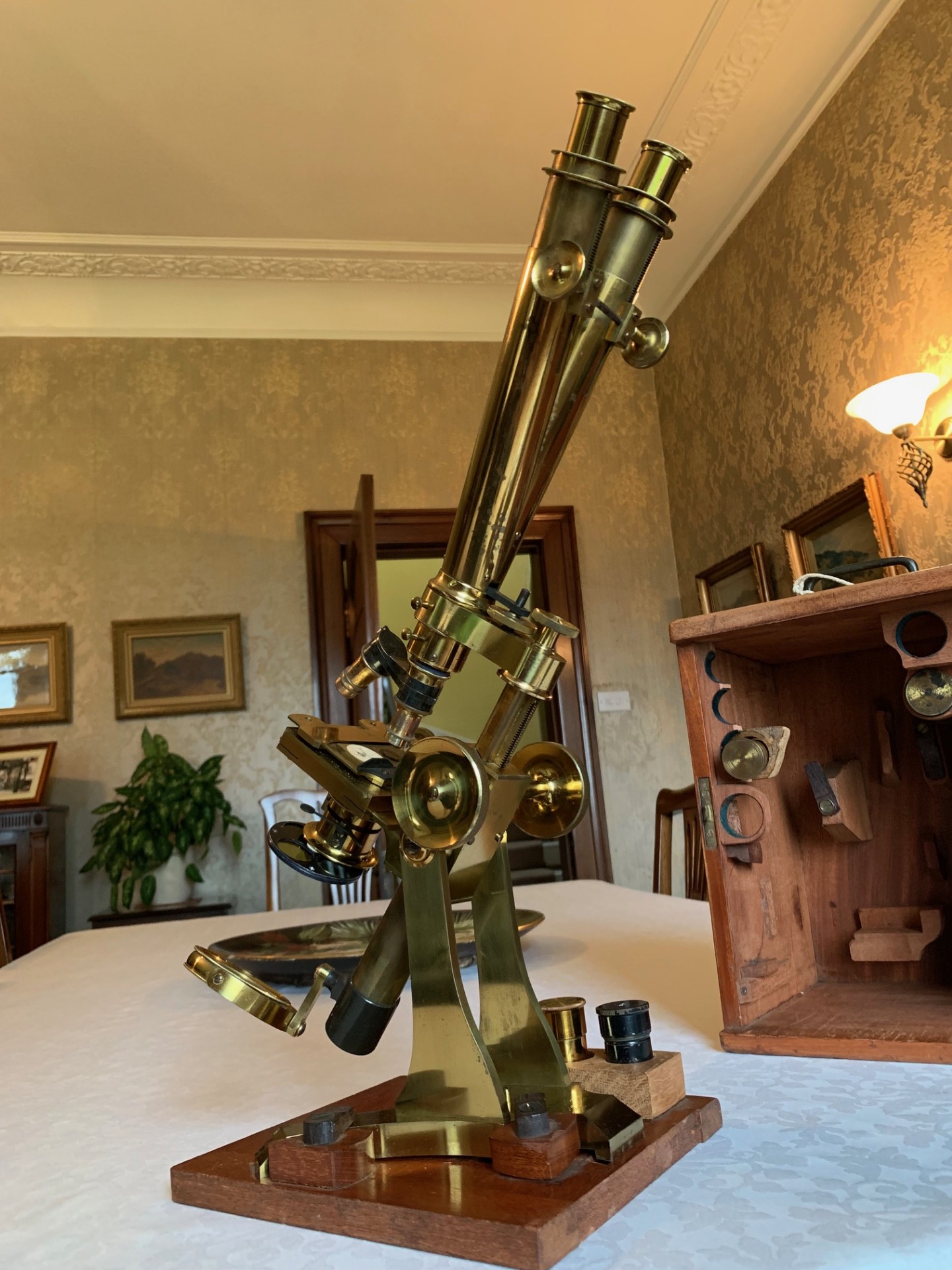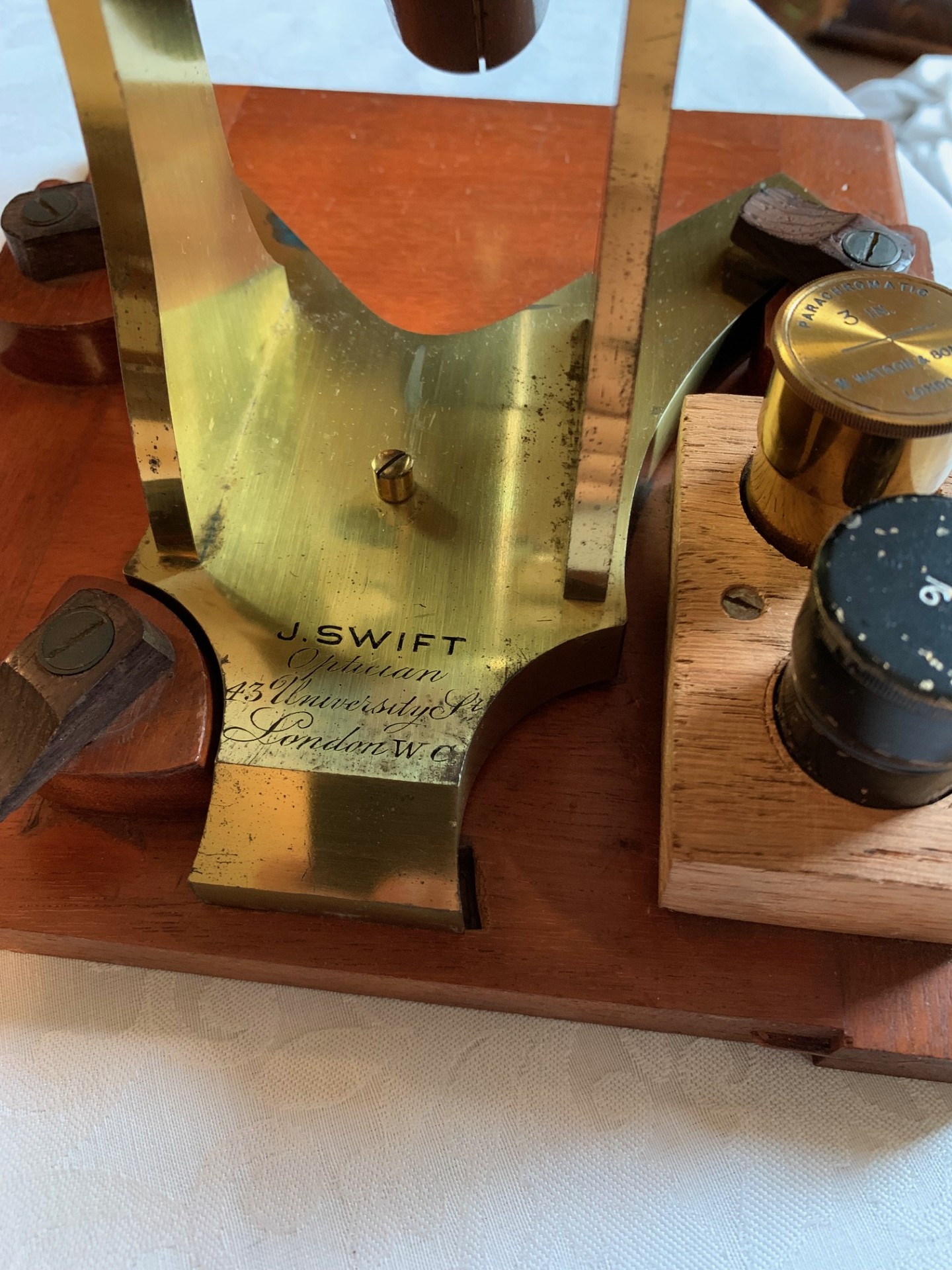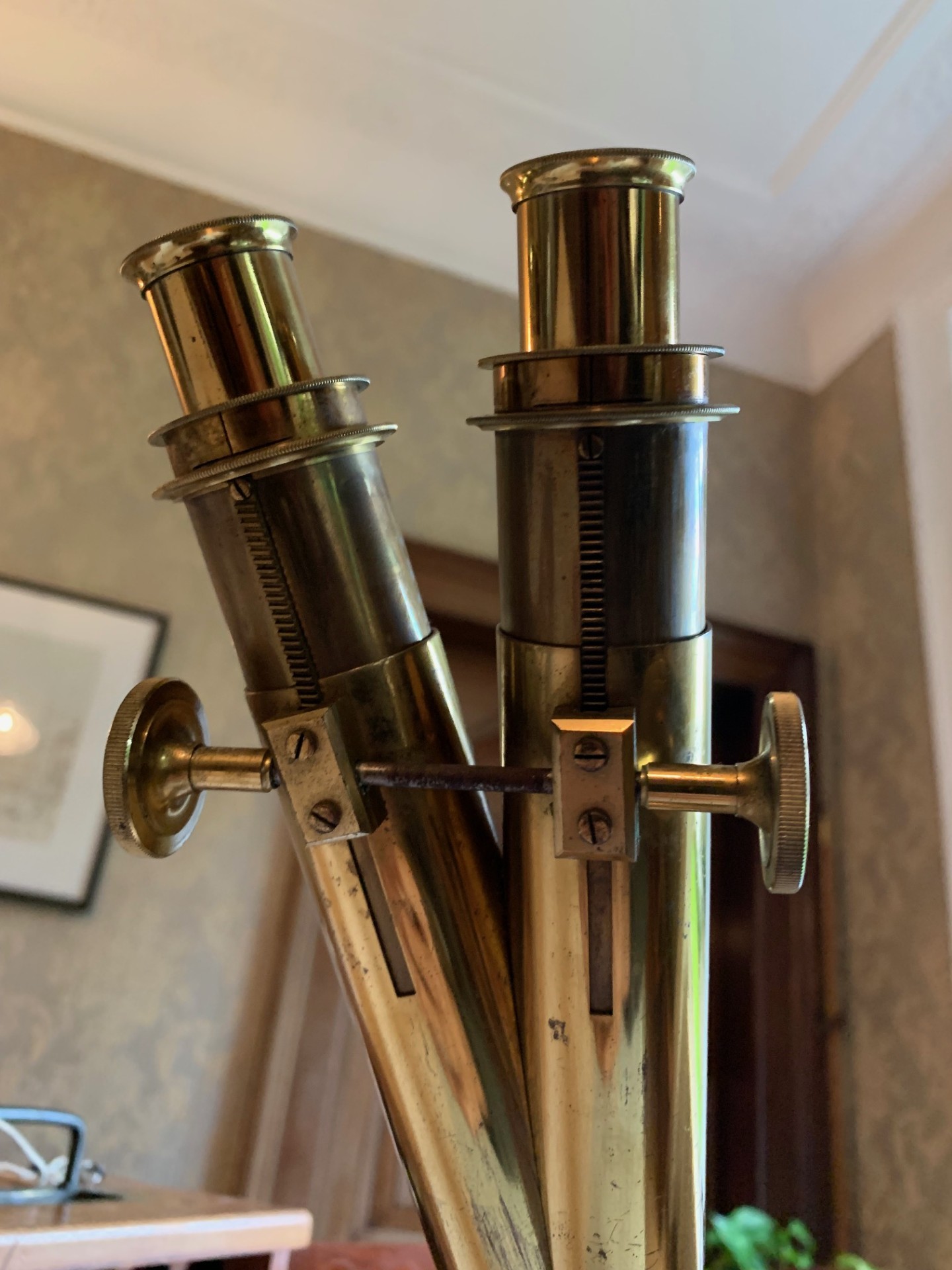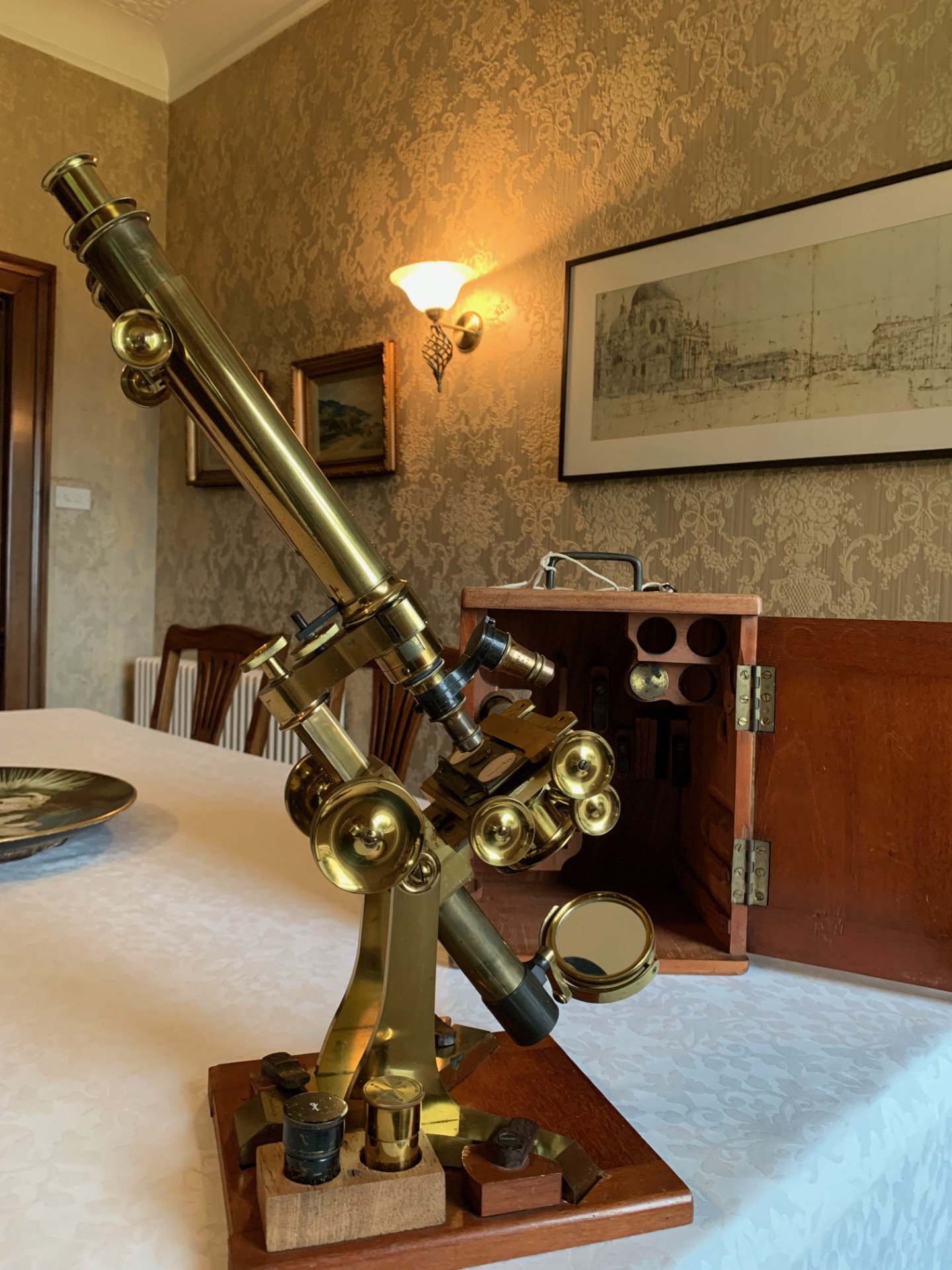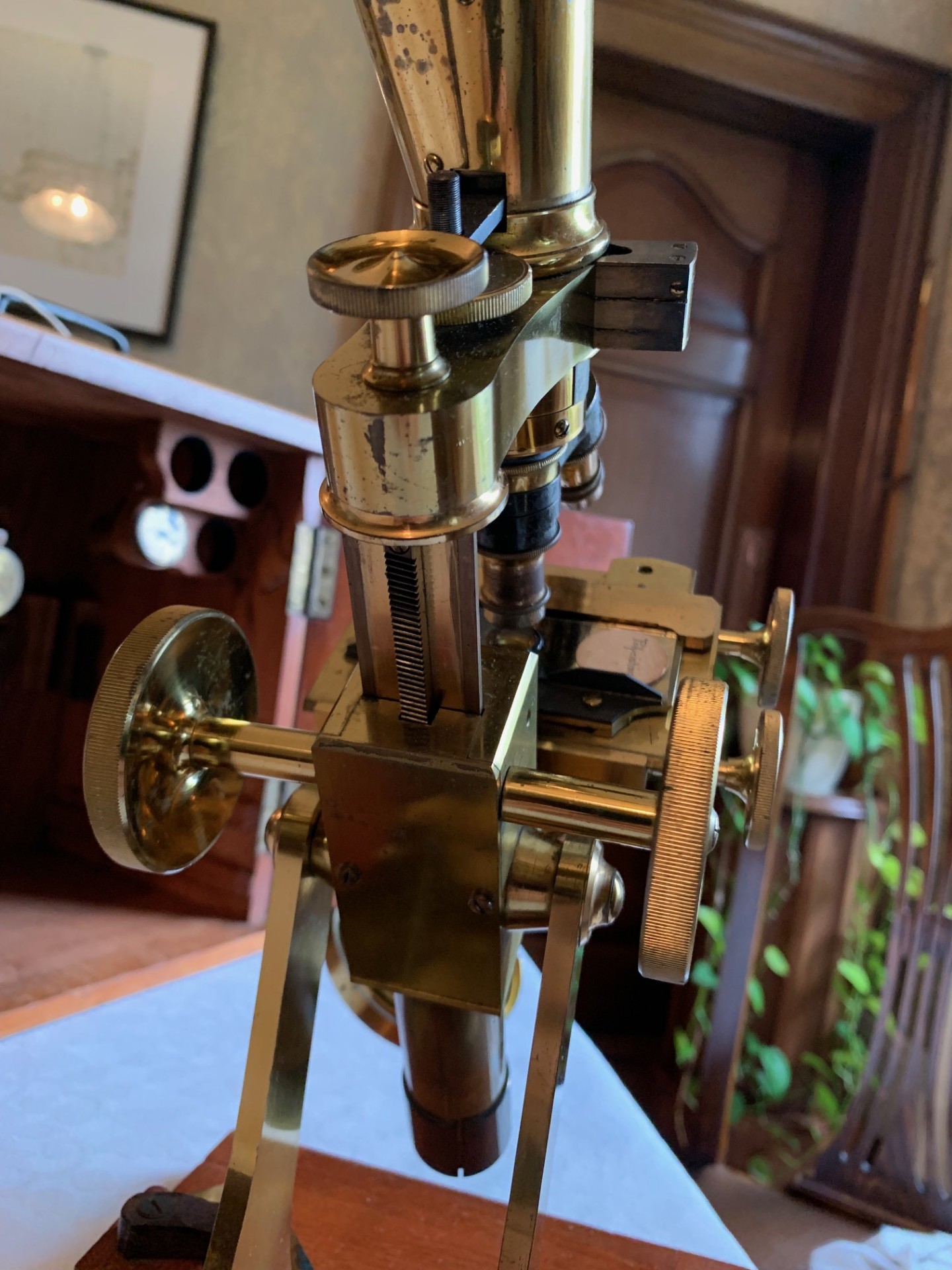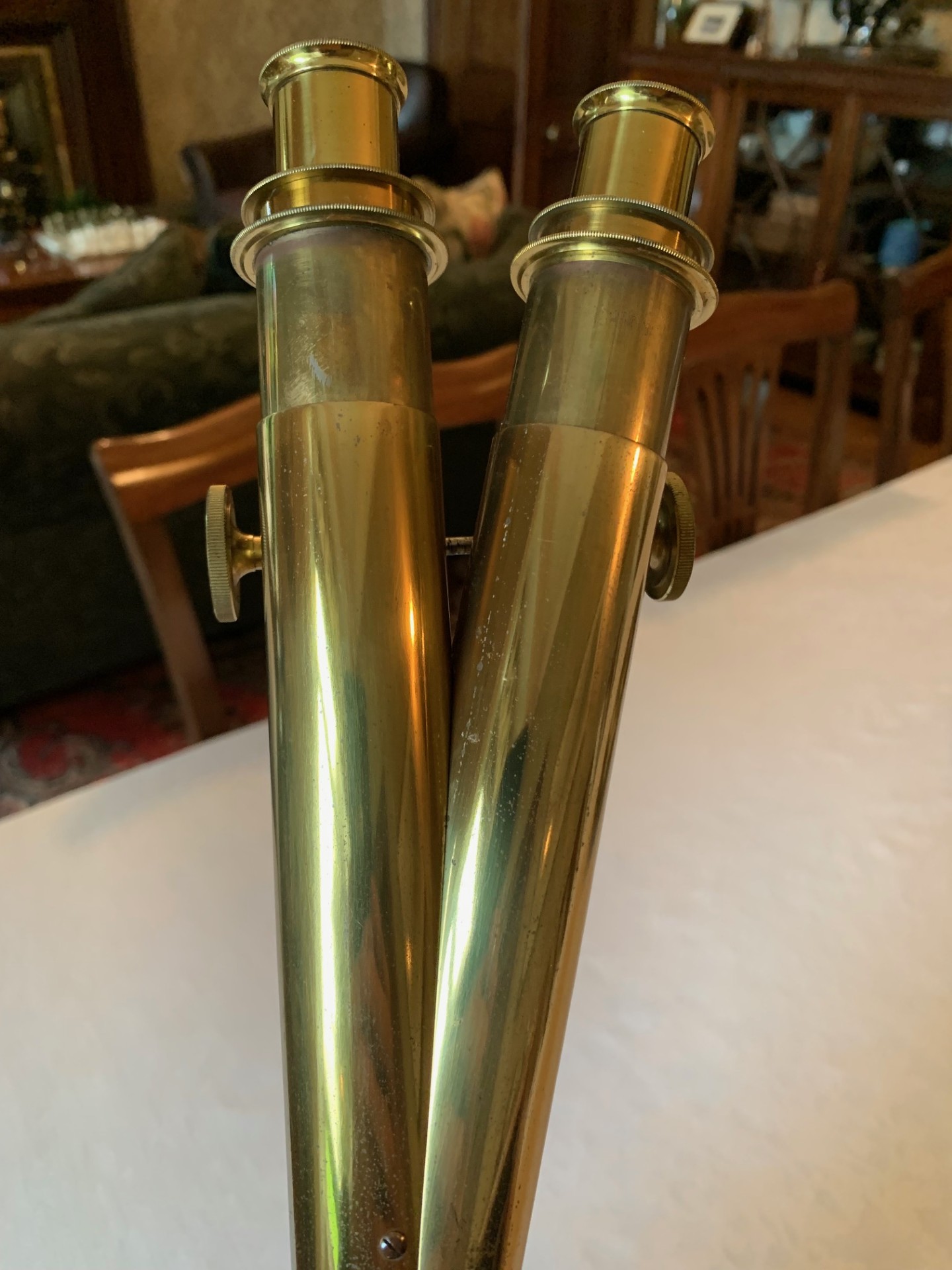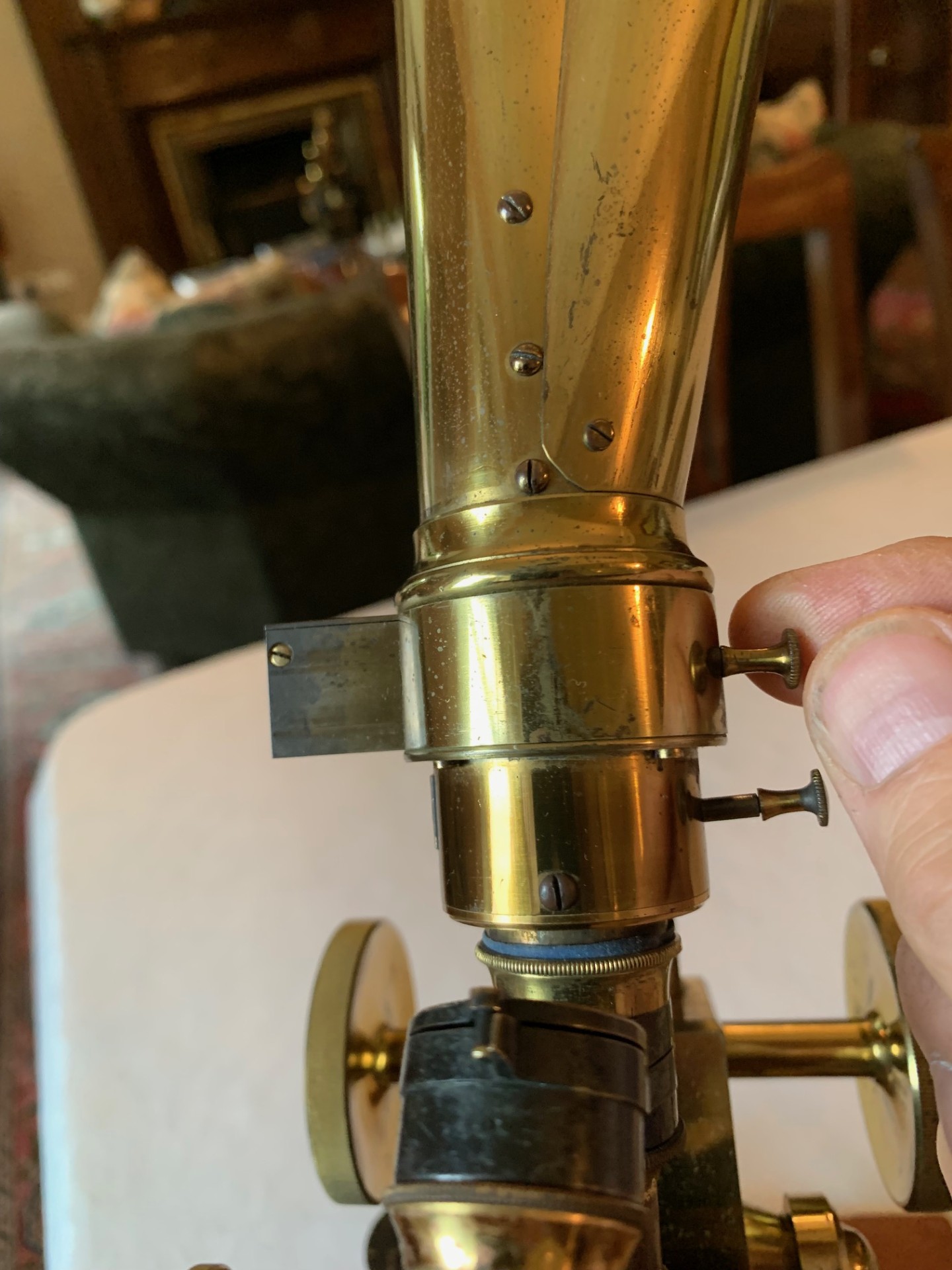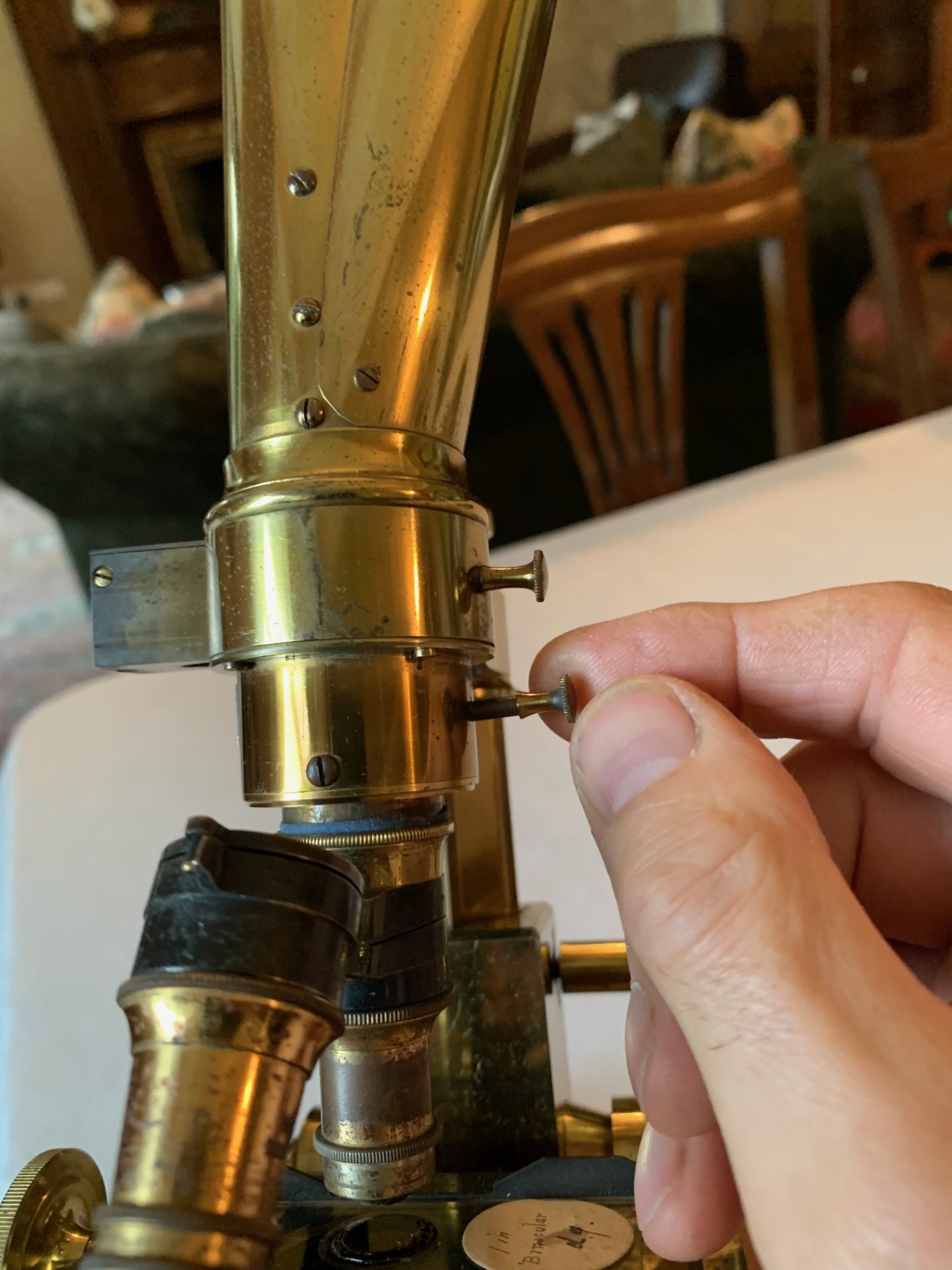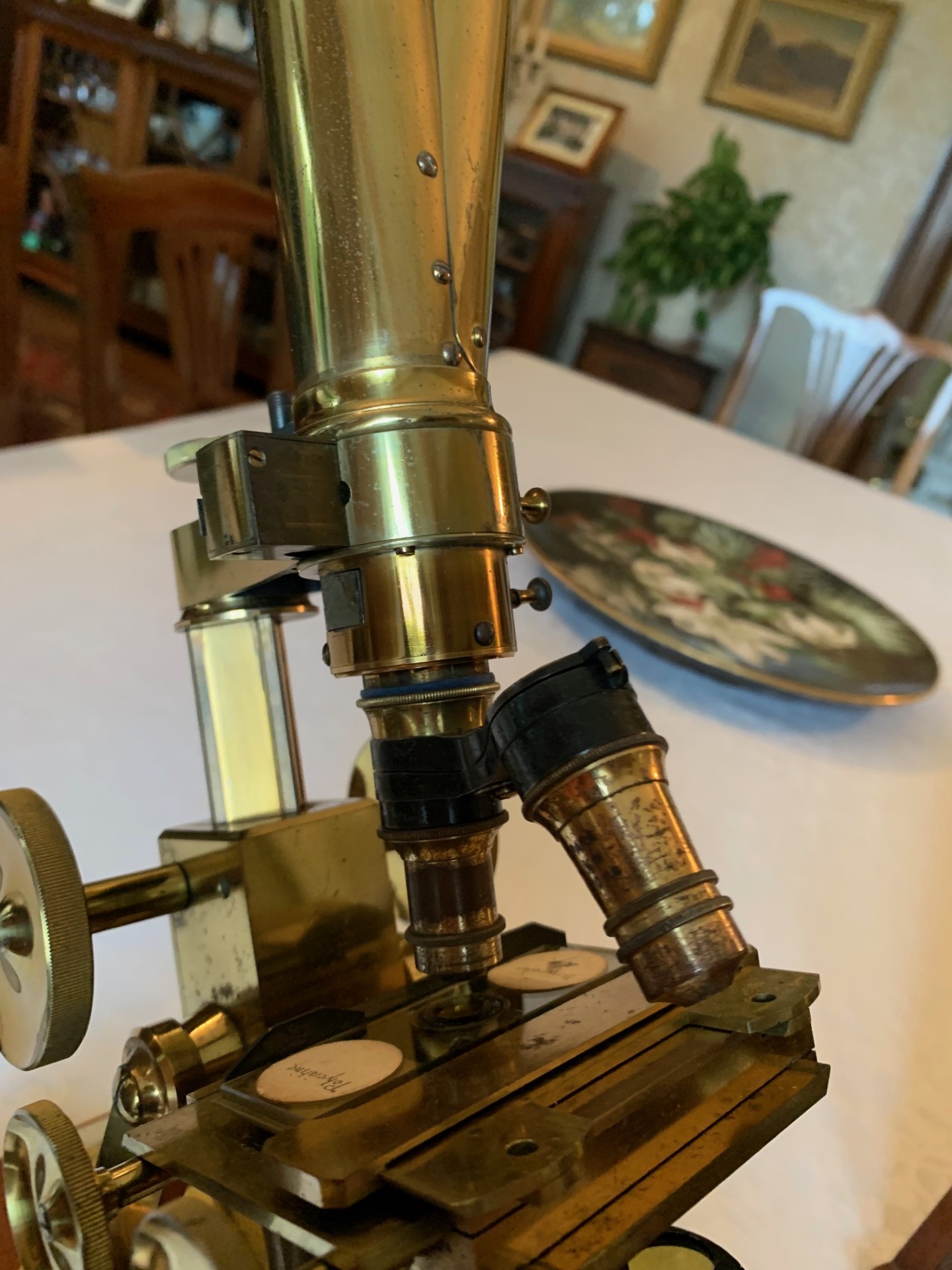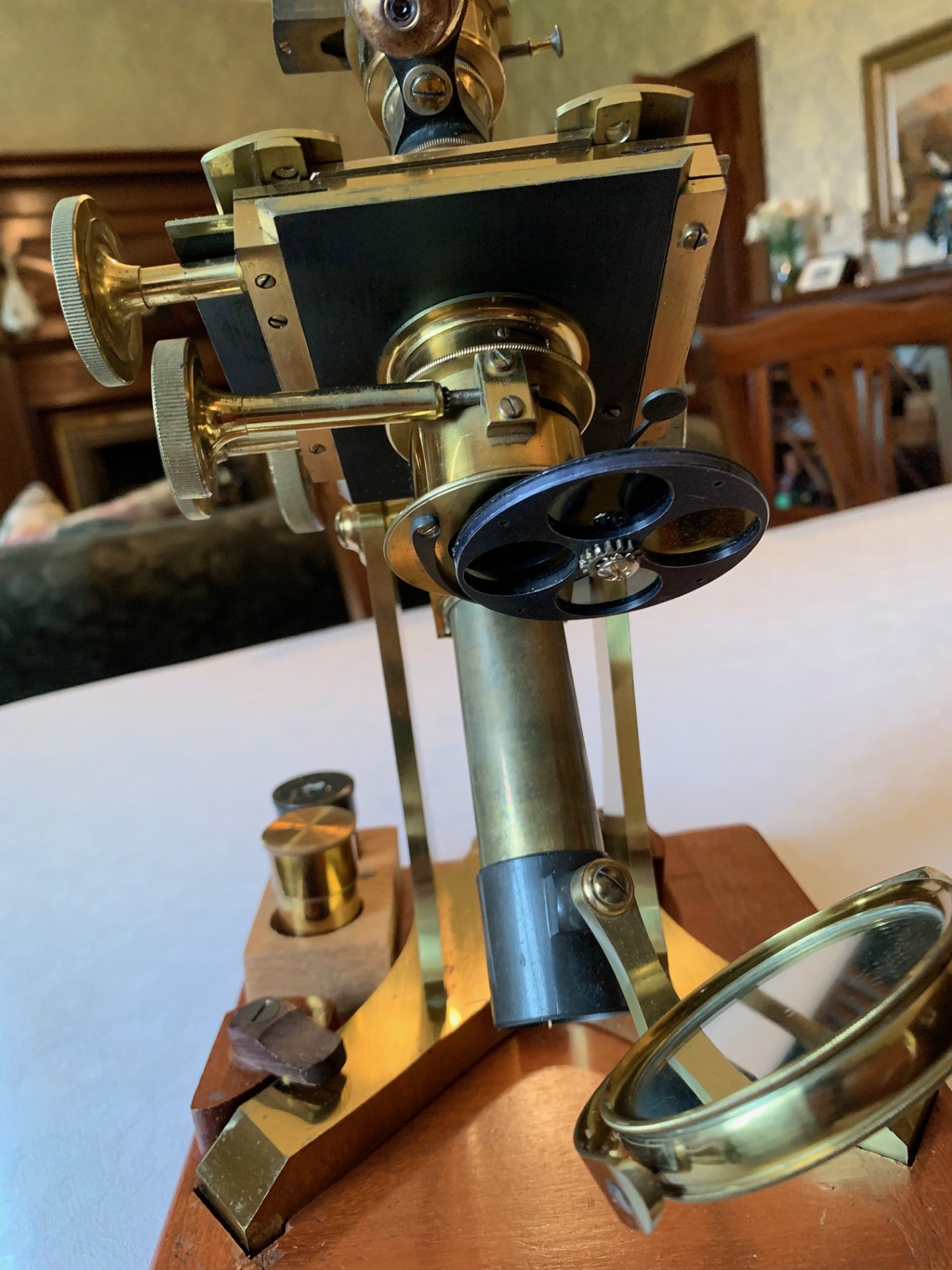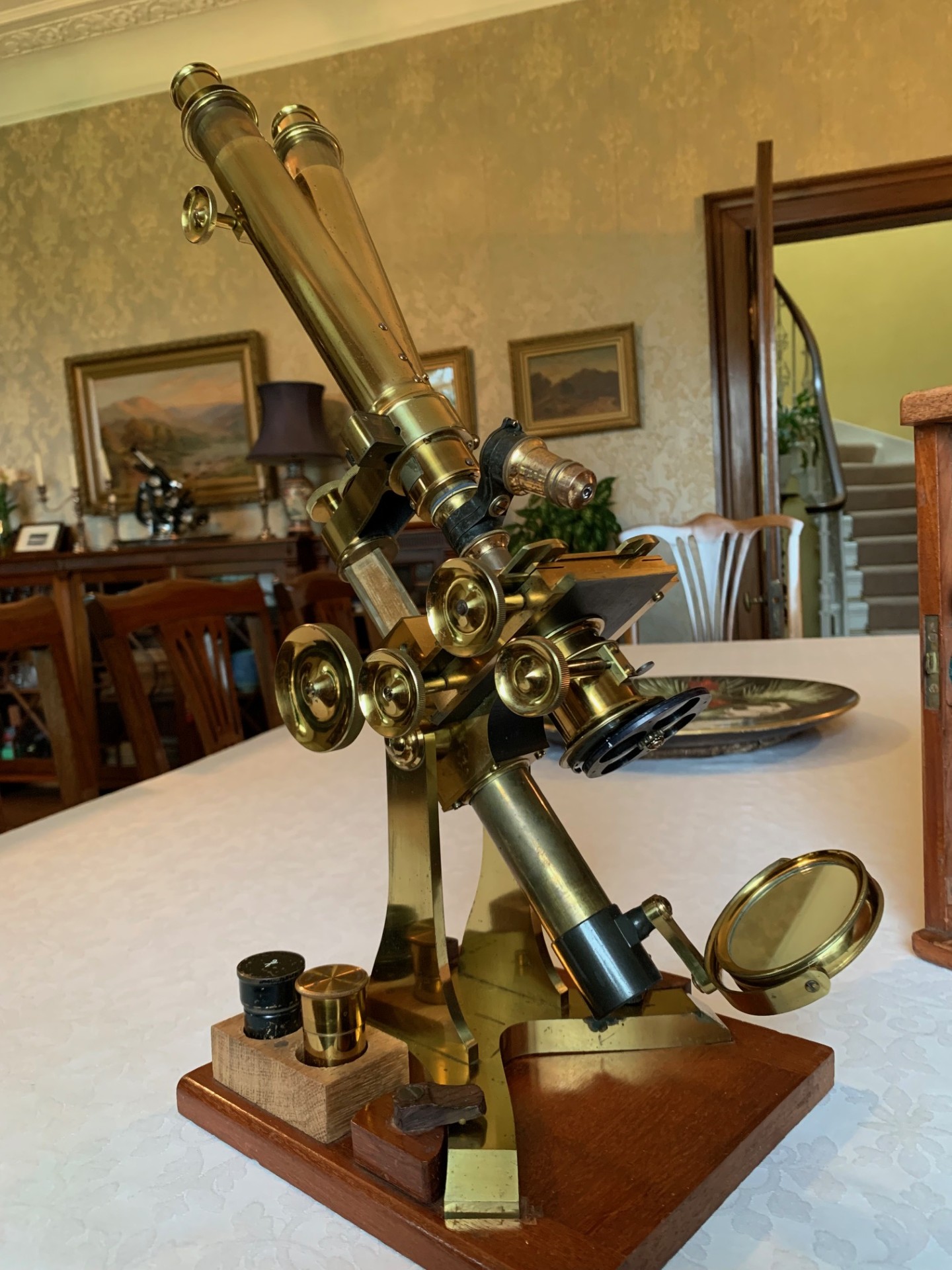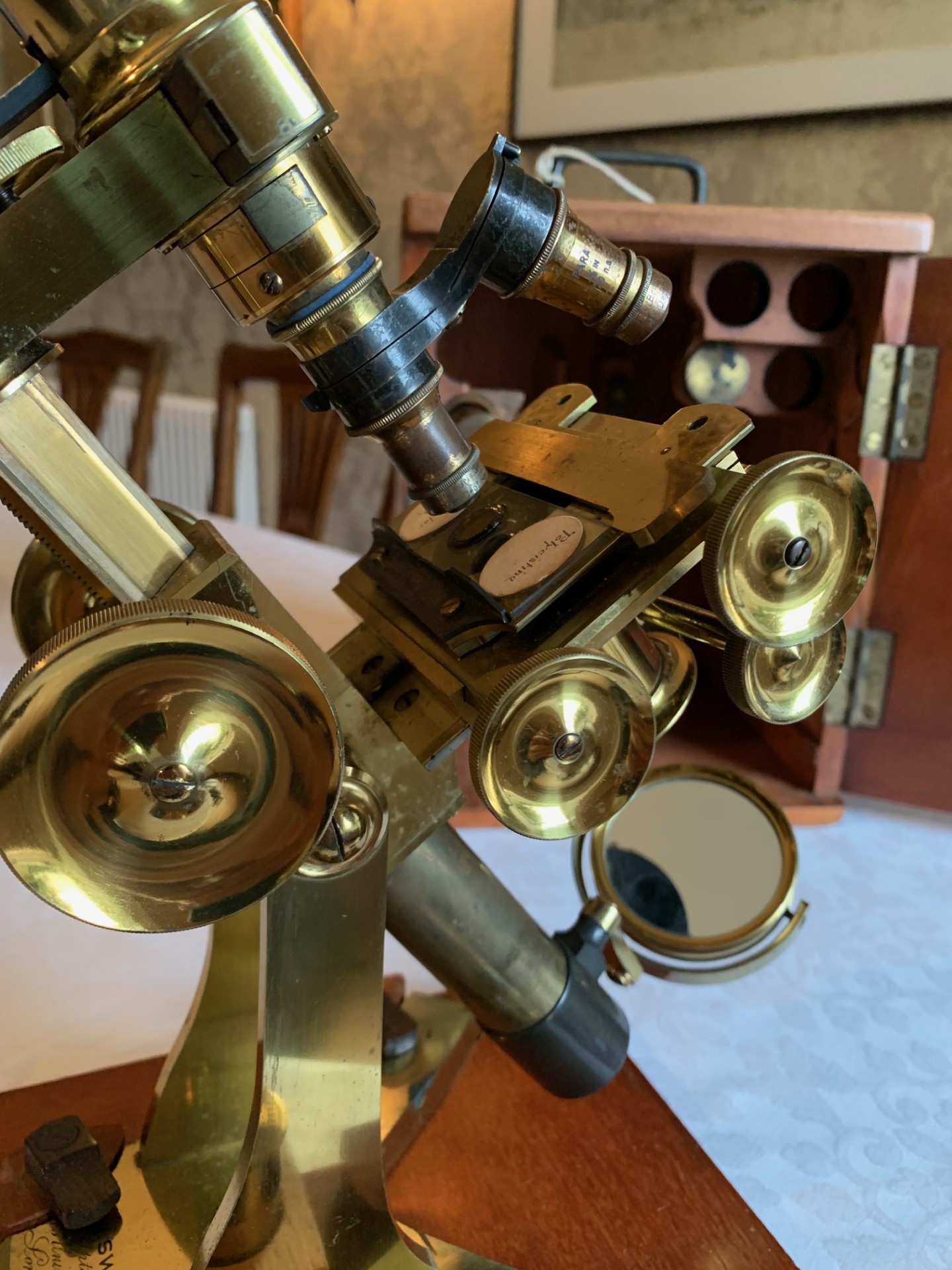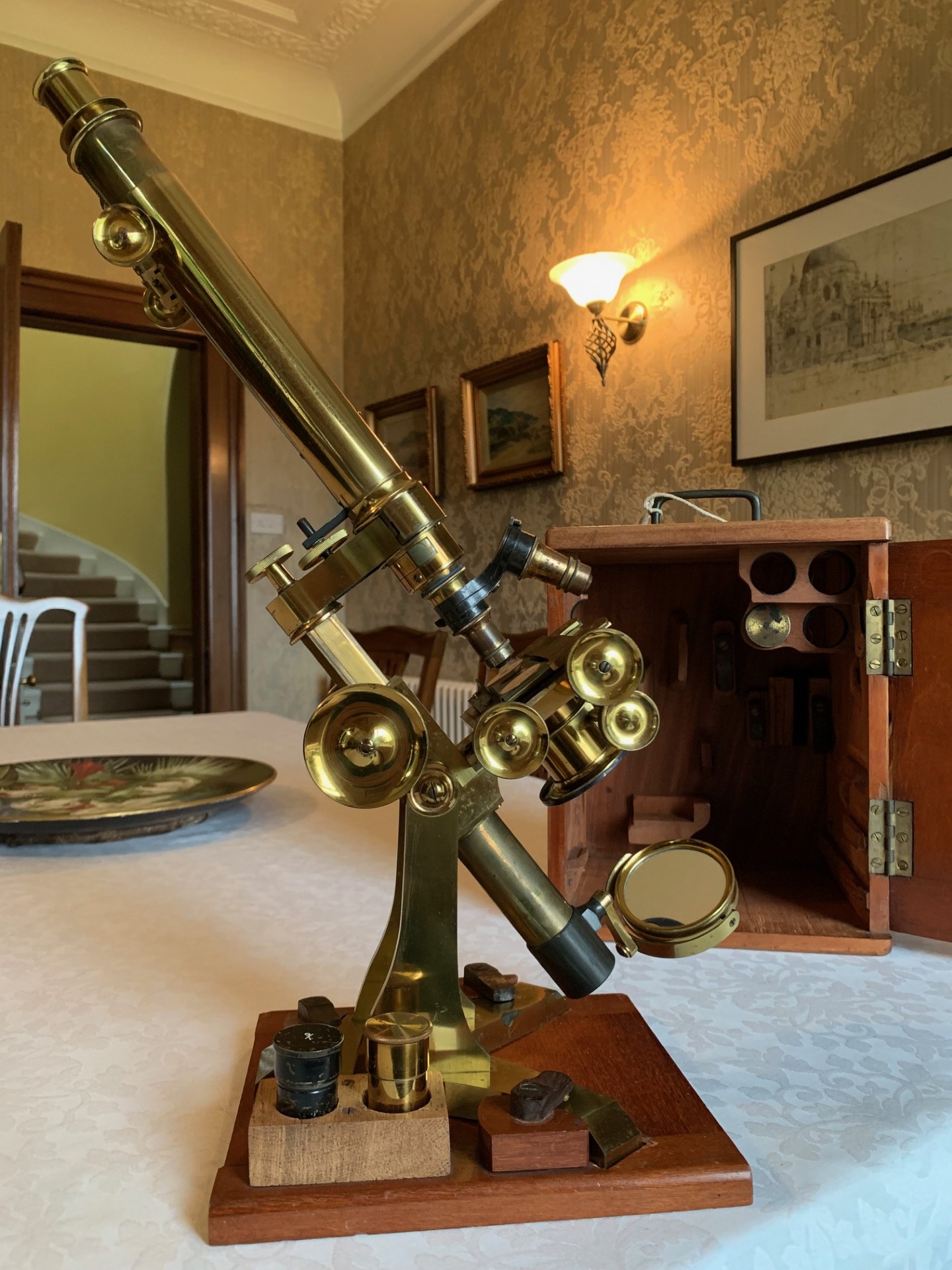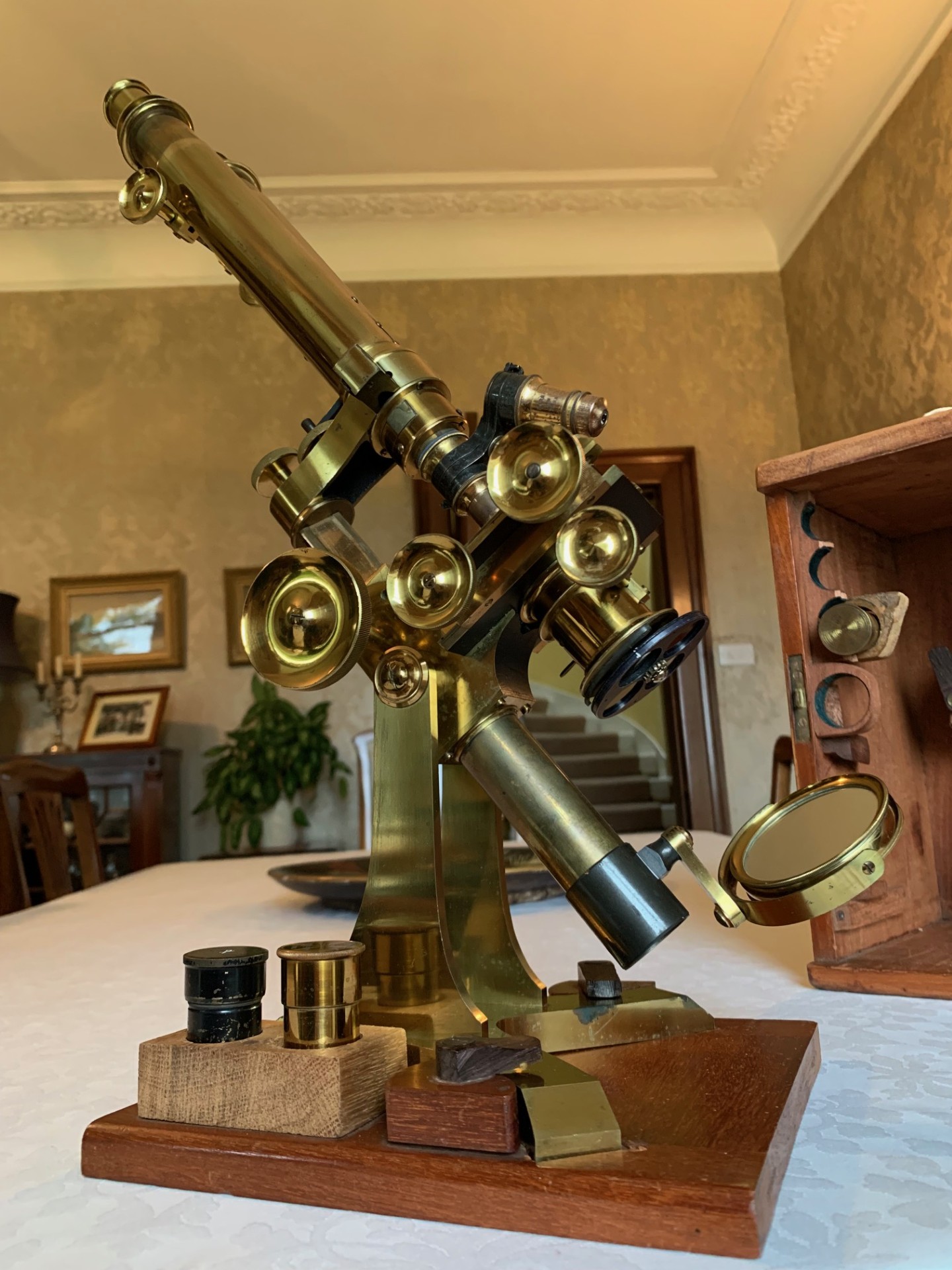SOLD – Antique No. 2 Wenham Binocular Brass Microscope James Swift, London c1880, Cased
Sold
Stunning and imposing antique binocular instrument by quality scientific instrument makers James Swift of 43 University Street London - most likely dating to the period around 1880. Really good cosmetic example of a James Swift No. 2 bar-limb with Wenham binocular tubes and its correct case.
Circa
1880
Maker
James Swift of London
Country of manufacture
UK and Ireland
Description
– Y-shaped foot with bar-limb design
– Wenham binocular with mechanical draw-tubes
– RMS objective fitment
– diagonal-cut coarse focus rack
– nose-piece fine focus
– mechanical stage with x/y controls to RHS
– adapted Swift universal condenser with adjustable optics
– large plano-concave reflector with good silvering
Background and timeline for James Swift from Microscope Museum’s website:
The firm James Swift were microscope makers trading from London, founded in 1853 by James Powell Swift, who was originally apprenticed to the well-known microscope maker Andrew Ross.
In 1881 James Swift brought in important improvements to microscope design, including replacement of straight rack and pinion focusing mechanisms with diagonal/helical cut components, along with a new style of fine focus mechanism. By 1884 James Swift’s, son Mansell had joined the company, so the firm’s name was therefore changed to James Swift & Son.
Captain Scott was supplied with Swift microscopes for use on the RRS Discovery for his 1901-1904 expedition, with the instrument named in the catalogue of the time as the ‘Discovery’ model.
In 1903 James Swift’s grandson also joined the company.
In 1906, the founder of the company, James Powell Swift, died.
In 1912, the company was incorporated as a limited company and the firm’s name changed to J. Swift Ltd.
This example of a Swift bar-limb binocular microscope presents really well with lovely gleaming brass-work details and some age-appropriate patination here and there mainly to the y-shaped foot, although nothing detracts from the visual appeal, which is what you’d hope for with an antique instrument of this age. The instrument’s look and feel is of a quality not found in modern microscopes in that’s it’s fashioned from solid brass, giving it a really solid feel and it’s also quite a large instrument at around 18 inches working height when extended and inclined for use. I hope that the listing photos do the instrument justice and showcase both its size and fine period condition.
Technical details – the construction is a brass y-shaped foot sitting on a mahogany base-plate, with twin uprights supporting a pivot and a classic triangular section bar-limb arrangement. The coarse focus is by rack and pinion with over-size thumb-wheels and interestingly the newer-style helical/diagonal cut rack that features on instruments from the 1880s onwards – hence my opinion on dating the instrument. The coarse focus has a smooth action and holds in position as it should in its working range. Fine focus is operated via a knurled brass thumb-wheel located at the rear of the main tube on the limb, being a vernier screw acting on the nose-piece only, that also works well.
In terms of its optics, this microscope has the Wenham double optical tubes with mechanically operated graduated draw-tubes with nice smooth action. The Wenham prism is present in its carrier in clean condition, rendering good usable images to both eyepieces when correctly positioned via the slider mechanism. It’s supplied with a pair of approx 8x magnification top-hat eyepieces that with correct illumination produce nice bright age-appropriate images. It’s currently got an after-market double turret and two Watson parachromatic RMS objectives of 2/3rds inch and 1/6th inch, giving 10x and 40x magnification options. With the objective fitting being RMS, there are plenty of other objectives by Swift and other makers that will also fit.
I’ve tested the optics with numerous antique slides of diatom, insect and other similar specimens and the images are perfectly acceptable when using good illumination – in fact this is quite a good Wenham binocular set-up, with nice sharp bright images in both eyepieces when the Wenham prism and illumination mirrors are correctly positioned. It’s also interesting to see that there’s also a nose-piece analyser fitted to the optical tube on and in/out slider located directly above the Wenham prism, this feature hasn’t been tested and would benefit from a careful clean. The magnification available with the instrument with its current set of optics will be around 80x to 320x.
The instrument tilts for inclined viewing and holds in position as it should on inclination and can be tightened at the pivot as may be required. The all-brass specimen stage is fully mechanical with the x/y adjustment thumb-wheels on the right-hand side, giving about 1 inch of travel in the x/y planes. All the mechanical controls work very well and hold position on inclination. The stage top-plate has a rest for holding slides and it also rotates through a full 360 degrees, with good damping so that it holds position on adjustment.
Turning to the sub-stage, there’s an adapted version of a Swift universal condenser fitted to a ring-mount. This condenser has adjustable optics via a rack & pinion system with single-sided thumb-wheel control. It’s also got an integral two-position lever-operated dark-field stop on a swing mechanism that works really well. Instead of the usual wheel-of-stops, there’s what looks like an after-market rotor with coloured filters also fitted to the underside of the condenser. For reference purposes, there’s an image in the listing photo-stream of this Swift model of condenser from the original Swift catalogue. Lighting is via a plano-concave mirror in a brass gimbal mount with slider fitted to the limb tail-piece – this has good degrees of adjustability via rotation and height adjustment, thereby allowing oblique illumination – also with good silvering to both sides.
The instrument has been very gently dusted and also lightly lubricated with non-hardening grease where appropriate, so that the controls operate smoothly. This example of a Swift binocular displays exceptionally well having some lovely brass-work detailing, with rich gold tones which catch the light beautifully. It will no doubt make a stunning and quite usable antique display centre-piece, perhaps in a library or home office type of setting, especially when set up with an appropriate antique slide. There’s also the original case with the instrument that’s in decent period condition with recessed brass carry-handle, working lock & key and internal fittings. The case exterior sheen is a little sun-faded in parts and the door is also stiff in operation, but still mainly original.
Owing to the weight and delicacy of this antique microscope and its case, it will be partially dismantled, carefully wrapped for shipping and dispatched by insured courier upon receipt of cleared funds.
Thanks for looking.
Ask the Dealer
Dealer information
 Arcboutant Scientific
Arcboutant Scientific
Arcboutant Scientific based in Glasgow Scotland, with an interest in scientific collectables dating back to 1988. Now making available carefully curated fine examples, principally of antique microscopes and associated scientific equipment by quality English and Continental makers, to collectors world-wide.




